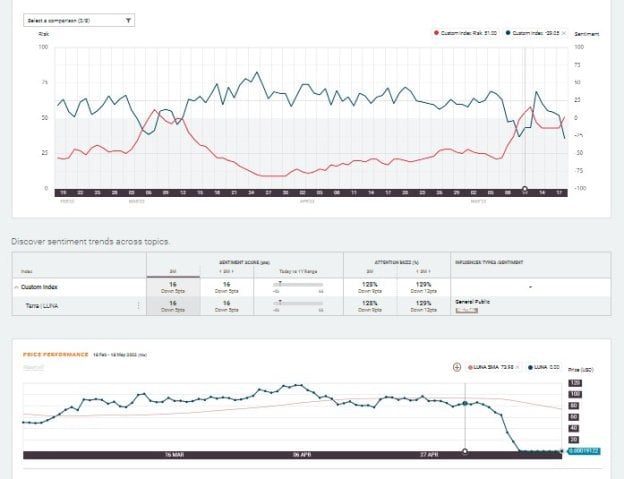It was already becoming apparent in April that the Terra LUNA project was at risk. This was revealed by Sentifi’s Terra LUNA Risk Score, according to which the perceived risk level did not exceed 10 until 30 March.
Summary
Terra LUNA project default risk on the rise as early as April
Starting on 31 March, Terra LUNA’s Risk Score began to rise, so that by 27 April it had reached 28, an increase of 211% in less than a month.
On 5 May, LUNA’s price started to fall significantly, and on the 8th the collapse began.
According to Sentifi, this trend could explain why a series of sell-offs on the crypto markets occurred after the end of April, which then led to the collapse of LUNA and UST.
For instance, as far as UST is concerned, its market value from mid to 24 April had often been even above $1, albeit by a small amount. From that very day, however, it went on to be almost always below that threshold.
Initially it never fell below $0.99, but on 6 May it began to show some vague signs of weakness.
Then in April, there was a significant increase in the perceived risk on LUNA. On 5 May, a significant drop in its price began and on 6 May UST began to show signs of weakness.
On 8 May, the real crash was triggered, culminating in Black Wednesday on 11 May when the entire Terra ecosystem literally began to implode.

What is Sentifi’s Risk Score?
Sentifi’s Risk Score measures the changing perception of risk for individual crypto assets, using data from Twitter, news, forums and blogs as sources. The sentiment score takes into account all mentions (negative, positive and neutral), while the risk score focuses on negative contributions.
Its objective is to detect which assets are perceived negatively by a significant number of people, in order to detect possible market risks in advance.
Sentiment scores change very quickly, whereas risk scores follow a much more long-term approach, similar to ratings. In fact, it often remains stable unless something significant happens, as it takes into account not only daily mentions, but also historical ones. This is possible due to a time weighting that ensures that more recent information has a greater impact.
The previous negative event: Neutrino USD
It is worth noting that news of the loss of the peg for the algorithmic stablecoin USDN (Neutrino USD) had already spread on 5 April, and although this stablecoin had nothing to do with the Terra ecosystem, it may have instilled some doubt as to whether the algorithmic stablecoin could really hold.
Earlier, in mid-March, Terra’s founder, Do Kwon, announced his intention to buy $10 billion in BTC to support the value of UST.
$UST with $10B+ in $BTC reserves will open a new monetary era of the Bitcoin standard.
P2P electronic cash that is easier to spend and more attractive to hold #btc
— Do Kwon 🌕 (@stablekwon) March 14, 2022
This news, which at first was very favourably received by both the Terra community and the crypto market in general, after doubts began to spread about the resilience of non-overcollateralized algorithmic stablecoins such as USDN or UST, ended up amplifying the doubts.
It is not surprising that already in April, the Risk Score of Terra LUNA started to rise significantly, so much so that it is possible to say that the problems in that ecosystem did not come as a surprise at all.
While no one probably expected such a deep and sudden collapse, there were many who doubted the long-term sustainability of that system.
Moreover, this dynamic that had been in place since April may have somehow hinted to those who attacked LUNA in the markets that the right moment to attack it had arrived.




